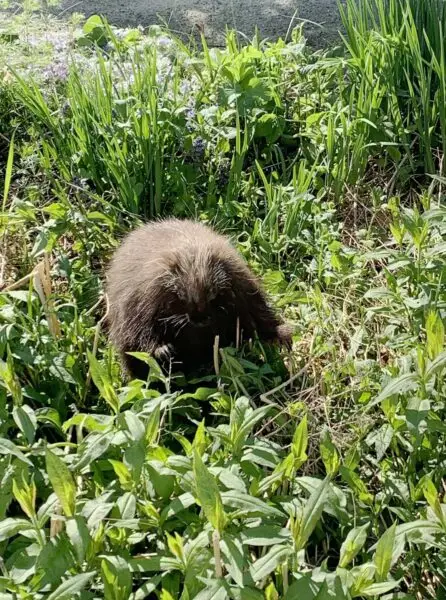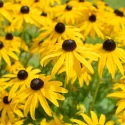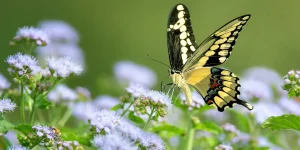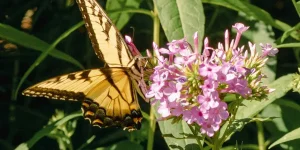Interview with Allison Cummings, New England Gardener
Starting a native garden in the Northeast presents unique challenges, from surviving harsh winters to coexisting with wildlife. New England native plant enthusiast Allison Cummings shares secrets of success gleaned from over a decade of native gardening, alongside some excellent native nurseries to visit. If you live in the upper Northeast, this is for you.
Thank you so much for the time Allison! Can you tell us a bit about yourself and your gardening background?
I didn’t grow up gardening or with gardeners in the family. In my later 20s, I started planting a few seeds by my apartments–cosmos, basil, or more—if the landlord allowed it. When I moved to New England in my later 30s and bought a house, I started reading gardening books in the long winters, dreaming about growing food and beauty. Then, the gardening obsession set in.
What region are you in?
Northern New England, zone 5.
“Growing food and beauty”—what a lovely way to put it. Now that we know a little about you, let’s discuss how you were introduced to native plants.
What inspired you to start a native garden?
I read Sara Stein’s Noah’s Garden and Douglas Tallamy’s Bringing Nature Home sometime around 2010, and those books really persuaded me that native gardens were not just pretty and lower maintenance but an ecological necessity for all insects and birds–and so for us.
I wish I had gotten interested and educated earlier; I'd have fewer plants to remove now!
How did you first get interested in native plants?
I wish I had gotten interested and educated earlier: I’d have fewer plants to remove now!
I became interested as I watched bees come out in early spring or buzz around in late fall with no apparent food in sight. I wondered how I might help plant what they were looking for.
After a long, snowy New England winter, your native garden must be a welcome sight for bees and other pollinators. With your wealth of experience in native gardening, we’re eager to hear some hard-won lessons you can share with beginners.
What advice would you give to someone just starting out with native plants?
Start small! Dig up just a small area so you won’t get overwhelmed or discouraged. Maybe leave it under mulch lasagne for a winter to thoroughly smother what was there or if the soil is poor, then plant in the spring.
While wildflower seed mixes can work, I’ve had more success buying small plants or trading with neighbors, since birds and chipmunks tend to scarf my seeds and seedlings before they can grow.
If you have a little more room, a shrub or tree can benefit pollinators, and give you shade or fruit or beauty. If you have a big yard, oaks apparently host the most critters, but if you have less space, a Serviceberry tree has spring flowers, blueberry-like fruit in summer (good luck beating the birds to it), red fall color, and is quite hardy. I see it planted in road medians.
If you’re thrifty and have time to wait, you can buy bare root seedlings from the NH State Nursery for a couple dollars each and have sizable trees or shrubs in 2-6 years.
I think “easy-to-grow” depends a lot on your soil, sunlight, and water, and, in my case, the wildlife who chomp what I plant.
Can you share some easy-to-grow native plants for beginners?
I think “easy-to-grow” depends a lot on your soil, sunlight, and water, and, in my case, the wildlife who chomp what I plant.
I once watched an aged porcupine traverse my yard, finding and eating all the tall phlox in the yard. After bingeing on her last craving, she turned up dead by the driveway.
(The phlox grew back.)
In my sunny, sandy, dry soil, Echinacea (coneflower) grows easily, Rudbeckias (Black-eyed Susans and tall laciniata) spread everywhere, woodland sunflowers do fine in full sun, tickseed, Obedient Plant, and various bee balms do well.
Native plants for beginners
Allison Cummings’s Picks
Living in the Northeast? Allison recommends these natives:
Are there any hard-to-find or specialty natives you love and wish were more known?
I’ve planted some types of Agastache (Hummingbird mint, Hyssop), and it’s beautiful, long-blooming, and a pollinator magnet. Obedient Plant (Physostegia virginiana) was new to me when a friend gave me some, but again, it’s a lovely pink in late summer, and the bees cover it.
A.M. Cummings’ Tip for Water-Loving Natives
I planted some “easy” natives near the house where I can water them, since they’d rather be near a stream: Culver’s Root, Snakeroot (Cimifuga), Joe Pye Weed, Boneset, Mountain Laurel, Redbud, and Penstemon.
Those are great plants and a great tip! Love the idea of putting plants that may need extra care nearby. Speaking of extra care…let’s talk about winter.
You live in an area that can have challenging cold winters. Are there any natives who haven’t done well in that environment?
Ah, yes, natives I’ve loved and killed. Let me alphabetize that list: Bluebells, Bloodroot, Columbine (Aquilegia canadensis), Ironweed, Lobelias, Mountain Laurel, Sassafras… These all prefer some shade and moist, rich soil, so it was likely more my soil & sun (and ineptitude) than the cold that did them in.
There are certainly plants that don’t grow here in zone 5, so I don’t try. I do notice that when we have cold and wind but no or minimal snow cover, I see more tree and plant disease and death, since they don’t have the blanket they’re used to or the slow soak of spring melt. New pests are also reaching us, like the Hemlock Woolly Adelgid.
The challenging part is finding them [native plants], but that has gotten easier over the years as more native plant nurseries pop up.
What challenges have you faced while growing native plants, and how did you overcome them?
The challenging part is finding them, but that has gotten easier over the years as more native plant nurseries pop up.
Do you have any favorite resources, such as books, websites, or local nurseries?
Yes! For books:
- Sara Stein, Noah’s Garden: Restoring the Ecology of Our Own Backyards (1993).
- Douglas Tallamy, Bringing Nature Home (2009) or Nature’s Best Hope (2020).
- Toby Hemenway, Gaia’s Garden: a Guide to Home-Scale Permaculture (2009).
- On a more dire note, reading Elizabeth Kolbert’s reporting on insect decline and E.O. Wilson’s idea to conserve “Half Earth” motivated me to step up my native plant offerings.
I’m so glad you mentioned Sara Stein’s Noah’s Garden. Sara’s book—published in 1993!—is seminal. She laid the groundwork (pun intended) for so much of the native awareness seen today.
Any other recs?
Yes! For websites:
- I use this one 🙂
- University cooperative extension sites for cold/Northeast climates like University of New Hampshire, or University of Maine
- Sometimes, The Spruce
Local nurseries:
- NH State Nursery sells bareroot plants in quantities of ten or more, but at $1- $2 for each Serviceberry or Winterberry, order ten and give some to friends! (Order in winter, plant in spring.)
- Local Conservation Districts and Audubon centers offer native plant sales in early summer (and fall), often bareroot, often at low prices.
- Found Well Farm (NH)- small scale grower of native plants, shrubs, trees.
- Bagley Pond Perennials (NH)- small scale grower of native plants.
- NH Native Perennials (White Mtns, NH)- “an elite [native] flower boutique”
- Stonefalls Gardens (NH)- a large, showcase nursery in Henniker, NH with lots of native plants, shrubs, trees.
- Elmore Roots (VT)
- Native Plant Trust in Mass has an extensive website and store, but MA is warmer than my area, so I stick to northern New England nurseries.
This list is amazing—thank you! We’ve added those nursery recs to our native nursery list.
As we round out our interview, is there anything we didn’t get a chance to cover?
I’m not above a little seed-bombing beyond my yard. When my town mows the roadside weeds down (often native plants) or someone clears a forest, builds a driveway, and then abandons the lot, I take a walk or bike ride with milkweed seed pods and do some strategic chucking.
The following season, I can see my work. So, if you don’t have any land, there are still ways to get more native plants out there, if that kind of guerilla gardening appeals to you.
Every big box store should have a (big) section for native plants, as most nurseries do.
Someday, I’d like to see native plants more “mainstreamed.” It’s happening a bit, but every big box store should have a (big) section for native plants, as most nurseries do. I’ve written to my local Big Boxes about carrying native plants but haven’t heard back. But maybe if more messages pour in, we might see some shifts?
Agreed. Here’s hoping the momentum continues to build.
Thank you so much, Allison. It was wonderful to hear about your successes (and challenges!) planting natives in the Northeast. Good luck battling the critters in your garden, and happy planting!
Further information
New Hampshire State Nursery
The NH State Forest Nursery has grown and sold plants since 1910. Bare-root plants are sold December-May; visit their website for more information.































